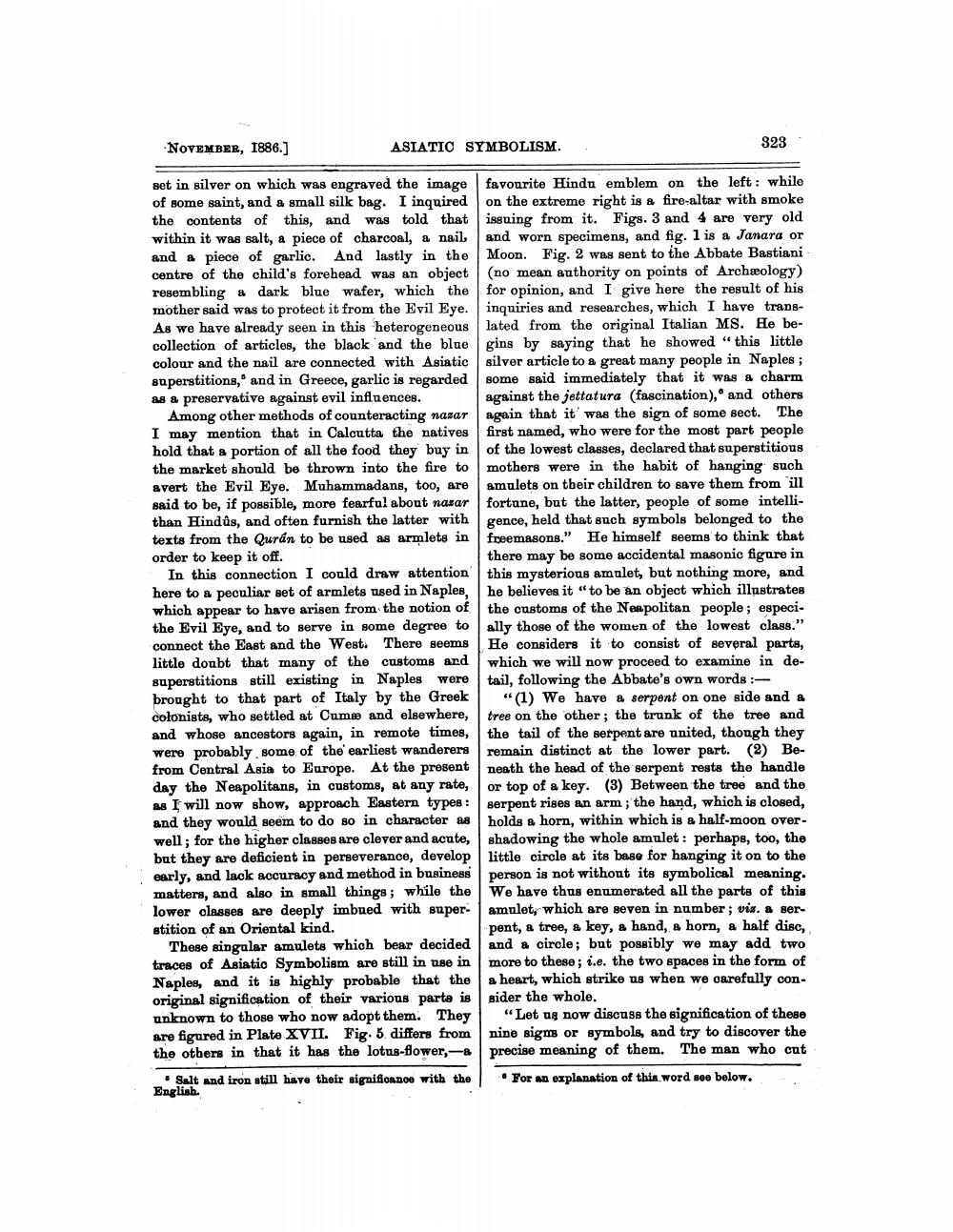________________
NOVEMBER, 1886.]
ASIATIC SYMBOLISM.
323
set in silver on which was engraved the image favourite Hindu emblem on the left : while of some saint, and a small silk bag. I inquired on the extreme right is a fire-altar with smoke the contents of this, and was told that issuing from it. Figs. 3 and 4 are very old within it was salt, a piece of charcoal, a nail and worn specimens, and fig. 1 is a Janara or and a piece of garlic. And lastly in the Moon. Fig. 2 was sent to the Abbate Bastiani centre of the child's forehead was an object (no mean authority on points of Archæology) resembling & dark blue wafer, which the for opinion, and I give here the result of his mother said was to protect it from the Evil Eye. inquiries and researches, which I have transAs we have already seen in this heterogeneous lated from the original Italian MS. He becollection of articles, the black and the blue gins by saying that he showed "this little colour and the nail are connected with Asiatic silver article to a great many people in Naples ; superstitions, and in Greece, garlic is regarded some said immediately that it was a charm as a preservative against evil influences. against the jettatura (fascination), and others
Among other methods of counteracting nazar again that it was the sign of some sect. The I may mention that in Calcutta the natives first named, who were for the most part people hold that a portion of all the food they buy in of the lowest classes, declared that superstitious the market should be thrown into the fire to | mothers were in the habit of hanging such avert the Evil Eye. Muhammadans, too, are amulets on tbeir children to save them from ill said to be, if possible, more fearful about nasar fortune, but the latter, people of some intellithan Hindûs, and often furnish the latter with gence, held that such symbols belonged to the texts from the Qurán to be used as armlets in freemasons." He himself seems to think that order to keep it off.
there may be some accidental masonic figure in In this connection I could draw attention this mysterious amulet, but nothing more, and here to a peculiar set of armlets used in Naples. he believes it “to be an object which illustrates which appear to have arisen from the notion of the customs of the Neapolitan people; especithe Evil Eye, and to serve in some degree to ally those of the women of the lowest class." connect the East and the West. There seems He considers it to consist of several parts, little doubt that many of the customs and which we will now proceed to examine in desuperstitions still existing in Naples were tail, following the Abbate's own words :bronght to that part of Italy by the Greek "(1) We have a serpent on one side and a colonists, who settled at Cumæ and elsewhere, tree on the other; the trunk of the tree and and whose ancestors again, in remote times, the tail of the serpent are united, thongh they were probably some of the earliest wanderers remain distinct at the lower part. (2) Befrom Central Asia to Europe. At the present neath the head of the serpent rests the handle day the Neapolitans, in customs, at any rate, or top of a key. (3) Between the tree and the
or top of a key. (3) Between t as I will now show, approach Eastern types : serpent rises an arm; the hand, which is closed, and they would seem to do so in character as holds a horn, within which is a half-moon overwell; for the higher classes are clever and acute, shadowing the whole amulet: perhaps, too, the but they are deficient in perseverance, develop little circle at its base for hanging it on to the early, and lack accuracy and method in business person is not without its symbolical meaning. matters, and also in small things; while the We have thus enumerated all the parts of this lower classes are deeply imbued with super- amulet, which are seven in number; via. a serstition of an Oriental kind.
pent, a tree, a key, a hand, a horn, a half disc, These singular amulets which bear decided and & circle; but possibly we may add two traces of Asiatic Symbolism are still in use in more to these ; i.e. the two spaces in the form of Naples, and it is highly probable that the a heart, which strike us when we carefully conoriginal signification of their various parta is sider the whole. unknown to those who now adopt them. They ! "Let us now discuss the signification of these are figured in Plate XVII. Fig. 5 differs from nine signs or symbols, and try to discover the the others in that it has the lotus-flower,-a precise meaning of them. The man who cut
Salt and iron still have their significanoe with the . For an explanation of this word see below. English




